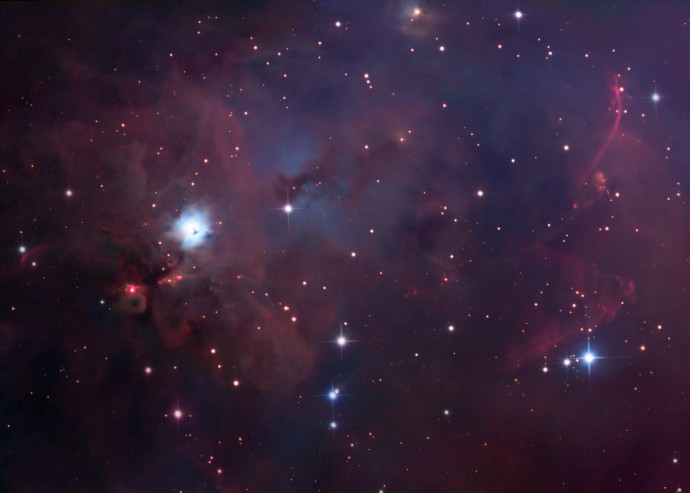
|
Credit & Copyright: Robert Gendler
Explanation:
South
of the large star-forming region known as the
Orion Nebula, lies bright blue reflection nebula
NGC 1999.
The nebula is marked with a dark inverted T-shape at the
lower left in a
broad
cosmic vista that spans over 10 light-years.
The dark shape is a dense gas and dust cloud, or
Bok globule,
seen in silhouette against the bright nebula, and likely
a site of future star formation.
At the edge of the
Orion molecular
cloud complex some 1,500 light-years distant, NGC 1999's
illumination is provided by the
embedded variable star V380 Orionis.
The
region abounds with energetic young stars
producing jets and outflows that create luminous shock waves,
including HH (Herbig-Haro) 1 and 2 just below and left of NGC 1999, and
the apparent cascade
of reddish arcs and bow shocks beginning at the upper right.
The stellar jets and
outflows push through the surrounding
material at speeds of hundreds of kilometers per second.
|
January February March April May June July August September October November December |
| |||||||||||||||||||||||||||||||||||||||||||||||||||||||
NASA Web Site Statements, Warnings, and Disclaimers
NASA Official: Jay Norris. Specific rights apply.
A service of: LHEA at NASA / GSFC
& Michigan Tech. U.
Based on Astronomy Picture
Of the Day
Publications with keywords: NGC 1999 - reflection nebula - star formation
Publications with words: NGC 1999 - reflection nebula - star formation
See also:
- APOD: 2025 September 19 Á The NGC 6914 Complex
- APOD: 2025 July 10 Á Lynds Dark Nebula 1251
- APOD: 2025 June 23 Á W5: Pillars of Star Formation
- APOD: 2025 April 28 Á Gum 37 and the Southern Tadpoles
- APOD: 2025 March 26 Á Star Formation in the Pacman Nebula
- Reflections on VdB 31
- The Variable Nebula NGC 2261
